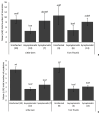Does This Look Infected? Hidden Host Plant Infection by the Pathogen Botrytis cinerea Alters Interactions between Plants, Aphids and Their Natural Enemies in the Field
- PMID: 38786903
- PMCID: PMC11121772
- DOI: 10.3390/insects15050347
Does This Look Infected? Hidden Host Plant Infection by the Pathogen Botrytis cinerea Alters Interactions between Plants, Aphids and Their Natural Enemies in the Field
Abstract
Few studies have considered whether hidden (asymptomatic) plant pathogen infection alters ecological interactions at the higher trophic levels, even though such infection still affects plant physiology. We explored this question in two field experiments, where two varieties of lettuce (Little Gem, Tom Thumb) infected with Botrytis cinerea were either (1) naturally colonised by aphids or (2) placed in the field with an established aphid colony. We then recorded plant traits and the numbers and species of aphids, their predators, parasitoids and hyperparasitoids. Infection significantly affected plant quality. In the first experiment, symptomatically infected plants had the fewest aphids and natural enemies of aphids. The diversity and abundance of aphids did not differ between asymptomatically infected and uninfected Little Gem plants, but infection affected the aphid assemblage for Tom Thumb plants. Aphids on asymptomatically infected plants were less attractive to predators and parasitoids than those on uninfected plants, while hyperparasitoids were not affected. In the second experiment, when we excluded natural enemies, aphid numbers were lower on asymptomatically and symptomatically infected plants, but when aphid natural enemies were present, this difference was removed, most likely because aphids on uninfected plants attracted more insect natural enemies. This suggests that hidden pathogen infection may have important consequences for multitrophic interactions.
Keywords: aphid; asymptomatic infection; multitrophic interaction; parasitoid; plant disease; predatory insect.
Conflict of interest statement
The authors declare no conflicts of interest.
Figures





Similar articles
-
Asymptomatic Host Plant Infection by the Widespread Pathogen Botrytis cinerea Alters the Life Histories, Behaviors, and Interactions of an Aphid and Its Natural Enemies.Insects. 2018 Jul 6;9(3):80. doi: 10.3390/insects9030080. Insects. 2018. PMID: 29986404 Free PMC article.
-
Multitrophic interactions involving genetically modified potatoes, nontarget aphids, natural enemies and hyperparasitoids.Mol Ecol. 2004 Mar;13(3):639-47. doi: 10.1046/j.1365-294x.2004.02078.x. Mol Ecol. 2004. PMID: 14871367
-
Facultative bacterial endosymbionts shape parasitoid food webs in natural host populations: A correlative analysis.J Anim Ecol. 2018 Sep;87(5):1440-1451. doi: 10.1111/1365-2656.12875. Epub 2018 Jul 16. J Anim Ecol. 2018. PMID: 29928757 Free PMC article.
-
Aphids, predators and parasitoids.Novartis Found Symp. 1999;223:60-7; discussion 67-73. doi: 10.1002/9780470515679.ch5. Novartis Found Symp. 1999. PMID: 10549548 Review.
-
Chemical interaction between undamaged plants--effects on herbivores and natural enemies.Phytochemistry. 2011 Sep;72(13):1683-9. doi: 10.1016/j.phytochem.2011.02.010. Epub 2011 Mar 7. Phytochemistry. 2011. PMID: 21388645 Review.
Cited by
-
An overview of symbiotic and pathogenic interactions at the fungi-plant interface under environmental constraints.Front Fungal Biol. 2024 Oct 25;5:1363460. doi: 10.3389/ffunb.2024.1363460. eCollection 2024. Front Fungal Biol. 2024. PMID: 39524061 Free PMC article. Review.
References
-
- Mazumdar P. Sclerotinia stem rot in tomato: A review on biology, pathogenicity, disease management and future research priorities. J. Plant Dis. Prot. 2021;128:1403–1431. doi: 10.1007/s41348-021-00509-z. - DOI
-
- Martinelli F., Scalenghe R., Davino S., Panno S., Scuderi G., Ruisi P., Panno S. Advanced methods of plant disease detection. Agron. Sustain. Dev. 2016;3:1–25. doi: 10.1007/s13593-014-0246-1. - DOI
Grants and funding
LinkOut - more resources
Full Text Sources
Medical
Research Materials

